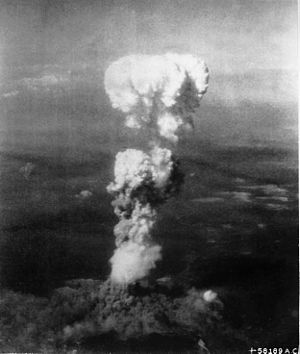Today, May 21st, is the anniversary of the first nuclear bomb, dropped over the island of Bikini Atoll. It is interesting to notice that in many of the news items about the anniversary, it was described as a test of the “hydrogen” bomb, instead of using the word “nuclear”. I would imagine that at this time in history, the powers-that-be do not want people making the connections between “nuclear weapons” and “nuclear power” that will reveal deep, philosophical problems with nuclear energy.
This posturing seems similar to the way that some nuclear power plants like to name themselves as merely “energy centers”. If you are wise enough to understand the risks of nuclear energy, you should try to apply the actual word “nuclear” wherever possible, as a way to keep the dialogue authentic.
I have been ruminating on how ironic it is that Japan, who knew the devastation that nuclear technology could cause due to Nagasaki and Hiroshima, would have so many nuclear facilities in place. It is ironic and heartbreaking, that the country with cities known as symbols for nuclear weapons devastation, would have invited in nuclear plants: Now the same country will have a city known as a symbol for nuclear energy devastation, as well.
Hiroshima. Nagasaki. Fukushima. It is a sad litany.
Some scientists are suggesting that the evacuees will never be allowed to return to Fukushima. And, there have been other hardships, including the threat of the radiation cloud moving around the world.
At various times over the last few weeks I have been mulling over the devastation and loss to people in Japan; reflecting on the (much smaller) loss to myself from the lost stream of food and products from Japan; and worrying that some of the cloud could arrive on my doorstep in New York. With these dark reflections in mind, I came across a movie which I hoped would provide a historical perspective. I took out the 1959 movie “On The Beach” from my library.
“On The Beach” tells the imagined story of what happens when — in the then future date of 1964 — there is a nuclear war, and the only people left on earth are the people living in Australia, and one, military submarine from the United States. The movie stars Gregory Peck, Ava Gardner, Fred Astaire (in a rare, dramatic role), and Anthony Perkins. It is very depressing, but rather profound. The movie is about the effects of nuclear war. Yet, it is also an interesting way to reflect on what a nuclear accident, under any circumstances, might mean. It dramatizes the effects of radiation sickness, and also, how it would feel to know that a radioactive cloud is coming your way.
The movie also reflects on how a whole country would respond to knowing the end was coming near, and how individuals would respond to the onset of radiation sickness. It presents ethical dilemmas even more profound than those found on the TV Show “What Would You Do”. “On The Beach” is not light viewing, but well worth the time to watch.
For more practical ruminations on the current nuclear situation, and what it might mean for the people of Japan, and the other people on earth, you might want to go over to the Nuclear Information and Resource Center. They have constant updates about what is happening in Japan. Donating to them is a way to help real science, and considered activists effect the current, nuclear dialogue.
______________________________________
Background and information:
From the Richmond Times-Dispatch: “1956 The United States exploded the first airborne hydrogen bomb over Bikini Atoll in the Pacific.”
From the Wikipedia entry on Hiroshima: “On Monday, August 6, 1945, at 8:15 AM, the Atomic Bomb ‘Little Boy’ was dropped on Hiroshima by an American B-29 bomber, the Enola Gay,[16] directly killing an estimated 80,000 people. By the end of the year, injury and radiation brought total casualties to 90,000–140,000.[17] Approximately 69% of the city’s buildings were completely destroyed, and about 7% severely damaged.”
From the Wikipedia entry on Nagasaki: “During World War II, the atomic bombings of Hiroshima and Nagasaki made Nagasaki the second and, to date, last city in the world to experience a nuclear attack.”
From the Wikipedia entry on the Fukushima nuclear accidents: “The Fukushima I nuclear accidents…are a series of ongoing equipment failures and releases of radioactive materials at the Fukushima I Nuclear Power Plant, following the 9.0 magnitude Tōhoku earthquake and tsunami on 11 March 2011. The plant comprises six separate boiling water reactors maintained by the Tokyo Electric Power Company (TEPCO)…experts consider it to be the second largest nuclear accident after the Chernobyl disaster, but more complex as multiple reactors are involved…”
Excerpt from updates at NIRS/Nuclear Information and Resource Service website (Favorite or Bookmark this website to stay informed on the nuclear situation in Japan):
Nuclear Crisis in Japan: Updates on Fukushima reactors and aftermath of Japan earthquake. Updated 2:30 pm, Friday, May 20, 2011. Media shocked by Fukushima meltdowns; more evidence Unit 1 meltdown began before tsunami, Tepco president resigns.
We expect the media to be equally shocked when they finally realize that the evacuees will never be returning home and that the world now has another piece of itself rendered uninhabitable by nuclear power.
Filed under: Ecology, energy, Environment, green, international politics, News, politics, progressive politics, public health, war Tagged: | atomic bomb, Atomic bombings of Hiroshima and Nagasaki, Bikini Anniversary, Bikini Atoll, Bikini tests, day in history, films, Fukushima, Hiroshima, hydrogen bomb, Japan, japan nuclear situation, movie history, Movies, Nagasaki, NIRS, Nuclear, nuclear energy, nuclear power, old movies, On The Beach, Tokyo Electric Power Company


 .
.





Leave a Reply